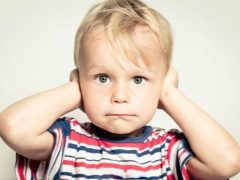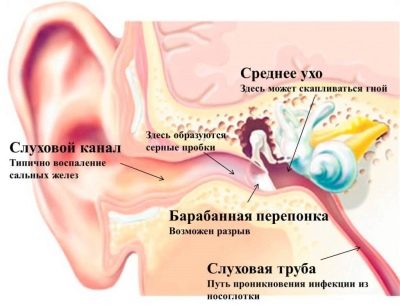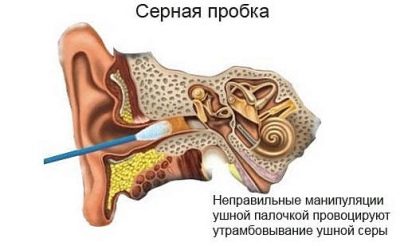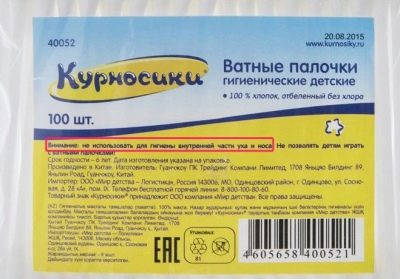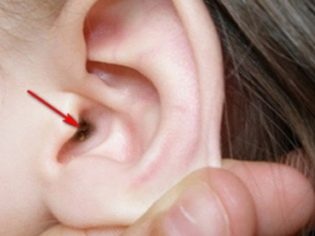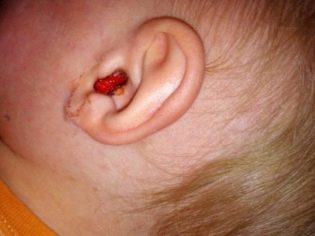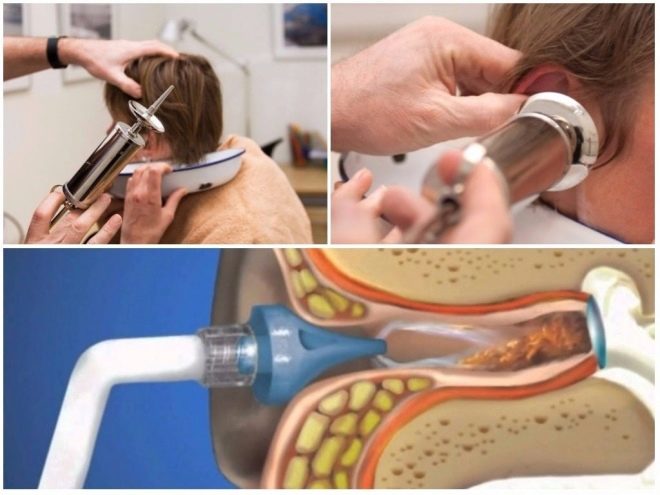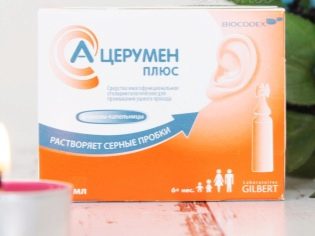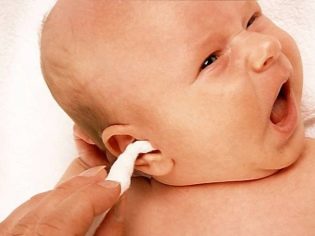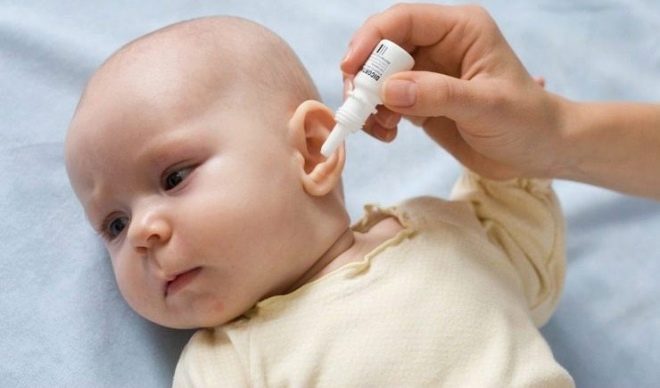Ear plug in children: features and removal at home
If a child complains about tinnitus and hearing loss, this does not mean that he has serious health problems. Perhaps the reason lies in a rather banal ear plug, which occurs quite often in childhood.
Its removal will help restore the ear to the full, the main thing is to do it right.
What it is?
The ear plug in medicine is called sulfuric: it is a question of the same name ENT pathology, the essence of which lies in the complete or partial blockage of the external auditory canal with a large amount of accumulated ear wax. This sulfur is the result of the work of the sulfur glands, which are located in the cartilaginous part of the external ear. It is produced so that the eardrum does not dry out, so that the ear naturally maintains cleanliness and order. Sulfur is mixed with the secret of the sebaceous glands, as well as with dust particles, peeling epithelium. That is the composition of the earwax earplug.
When a person sucks, swallows, speaks, chews, temporomandibular joints set in motion, and this movement allows the accumulation of sulfur to leave the ear in a natural way. This process is daily, nobody pays attention to it.
A stopper begins to form when this natural ear cleansing is difficult for some reason. Then it accumulates and gradually clogs the auditory canal, which is manifested characteristic signs.
Ear plugs are different. It all depends on what consistency they have. Allocate:
- paste-like traffic jams (light and yellowish, rather soft);
- plasticine (brown, thick and viscous);
- solid (dry, dark, sometimes almost black).
Corks are soft, if they are not removed in time, they tend to turn into a solid, dry form. If you do not remove the dry plug for a long time, it can cause pressure sores in the bone section.
The reasons
The reasons for which the child may be impaired process of natural cleansing the ear from the sulfur secretion, may be due to the fact that the sulfur glands begin to produce more secretion than is required. This happens if a child gets a foreign body into the ear, otitis starts, water often gets into the ears. Separately, it should be said about children who wear hearing aids and often use headphones - their ventilation of the auditory orifice is reduced, which causes the sebaceous and sulfur glands to work several times more actively.
Important! Parents who especially diligently clean the ears of children with cotton swabs themselves provoke the formation of an ear plug. The rods irritate the sulfur glands, to which they react by increased secretion. In addition, the parents push the sulfur deeper into the bony abalone with a wand and tamp it down.
Cotton swabs also pose a real risk of injury to the eardrum, and in 75% of cases of such injuries, doctors state that the membrane was injured with sticks, with which parents so diligently cleaned the ears of their beloved child.
But the mention of the fact that they can not be used for hygiene of the inner part of the ear and nose, is on the package.
Some anatomical features of the structure of the organs of hearing in a particular child may result in the formation of an earwax ear plug - if the auditory passages are narrow or tortuous, their natural self-purification is difficult for mechanical reasons. Such passages are usually inherited from one of the ancestors.
If the ear plug in a child forms with enviable regularity, then you should pay attention to the living conditions of the baby: it is possible that the house is too hot, the air is too dry.
How to recognize?
You should not assume that the cork is indicated immediately. For a very long time, it may go unnoticed and not show any signs.
Only when the ear canal is closed by 70% or more will the first symptoms appear.
Usually they are preceded by certain events in which cork swelling becomes possible, for example, bathing in a pool or the sea, visiting a bath, and ordinary bathing in a bath.
There is a feeling of congestion in the ear, subjective noise, ringing, there may be pain. A small child begins to scratch his ear, older children complain that they hear their own voice with an amplified resonance. This phenomenon in medicine is called autophony.
The auditory perception is declining that the child may not be felt at all, but others become noticeable almost immediately - the baby does not respond to the treatment at normal volume, asks, asks to make the cartoon louder.
If the stopper is located deeply and presses on the eardrum, symptoms such as coughing, nausea, and dizziness develop on the reflex level.
The cork itself is often visible even without special equipment; it looks like a dark spot inside the auditory canal.
What to do?
Many people think that the accumulation of sulfur in the ear is easy to get rid of on their own, at home. But this is a serious delusion, which may cost the baby hearing.
Any attempts to pull the cork out of the children's ear at home using sharp objects, tweezers, a pin, cotton swabs or other available means are absolutely unacceptable.
At home there is no way to assess the exact location, consistency of traffic jams. This can only be done by an otolaryngologist with a device such as an otoscope and a flexible probe to determine the density of the sulfur. The doctor also determines the exact size, location, presence or absence of related problems, such as pressure sores or pressure on the eardrum. And only after that a decision is made on how to free the baby’s ear from the unpleasant accumulation of sulfur secrets.
Therefore, with an ear plug, you should immediately contact the children's ENT in the clinic. This specialist will carry out all the necessary manipulations independently.
Flushing the ear canal
Most often in order to remove sulfur accumulation, apply flushing the ear canal. To do this, use furatsilina solution or a light weak solution of potassium permanganate, previously heated to the temperature of the child's body. If the fluid is hotter or colder, it is possible that, in addition to discomfort, the baby will have inadequate reactions of the vestibular apparatus.
For washing, a Janet syringe or a regular large 20 ml disposable syringe is used. Parents are asked to hold the child - he should not turn and fidget during the manipulation. His spontaneous movements can lead to mechanical injury to the ear. In the space of the auditory canal is directed under the pressure of a stream of fluid. The cork is gradually washed out.
But this method is effective only if the cork itself has a pasty or plasticine structure. If it is hard and dry, it is recommended to pre-soak it. For this purpose, parents are recommended two or three days to bury the child in the eye of hydrogen peroxide at a concentration of 3%. Then you will need to come to the reception again and try to wash the softened ear plug using the method described above.
Dissolving hard plugs
To dissolve hard plugs in the ears, there are special solutions, for example, “Remo-Vaks” or “A-Cerumen”. But the doctor will prescribe them only if the baby has never had a broken eardrum.If there was otitis, there are signs of inflammation now or the child has previously been diagnosed with hearing loss, the plug will not be dissolved - they will simply try to get it. For this, doctors use special tweezers and a probe with a hook at the end.
After the cork is removed, the doctor will once again carefully examine the diseased ear with an otoscope and advise you to close the ear canal for several hours with a dry cotton swab.
Attempts to remove the stopper at home without assessing its consistency, location, or size can lead to perforation of the eardrum, injury to the bony part of the external ear, or unintentionally pushing the stopper deeper.
Usually, after removal in a medical office, the unpleasant symptoms subside almost immediately, and hearing is restored within a few hours.
Prevention
A few simple rules will help prevent recurrence or avoid the primary formation of ear plugs: adults should remember that the humidity in the room where the child lives should be sufficient - about 50-60%. Then the probability of pathological obstruction of the auditory canal will be minimal.
To clean the ears, the baby needs not cotton buds, as some people think, but cotton turunds-flagella, twisted by themselves from ordinary medical cotton wool.
Many people think that sulfur plugs originate from a lack of hygiene, in fact in most cases they come from its excess. A certain amount of sulfur must be constantly in the ear to maintain a normal "climate" in which pathogenic microbes and viruses die. If you clean out all the sulfur regularly, then the glands will produce it in excess, with a reserve, which in itself increases the likelihood of pathological accumulation of secretions.
If the baby already had 1-2 episodes of earwax formation, then it is worth driving him to the ENT every six months for a preventive examination. And during a routine visit to a pediatrician with infants, you should always remind the doctor of the need to look into the ears, because the sulfur tube is clearly visible without special equipment, and therefore it can be detected even before the unpleasant symptoms of pathology start.
Reviews
According to the parents, left on the thematic forums on the Internet, some face the traffic jams several times a year. Especially often they appear in children aged 2-3 years. About the procedure of washing the abalone the reviews are not too positive - children usually take this manipulation quite hard, some even have nausea and headaches.
For prophylaxis, many use Remo-Wax drops if there are no contraindications. Moms claim that this baby ear care product not only allows you to forget about the accumulation of sulfur, but also is an effective prevention of otitis.
Read more about ear plug in children in the next video.
